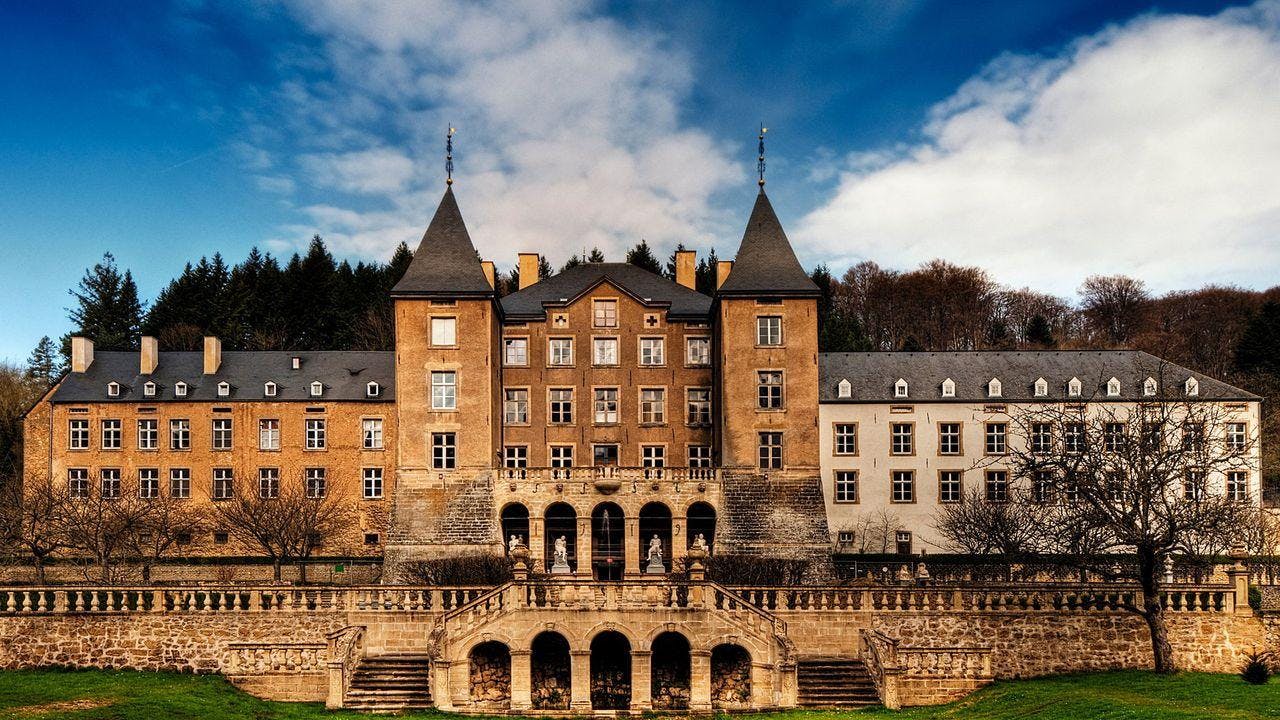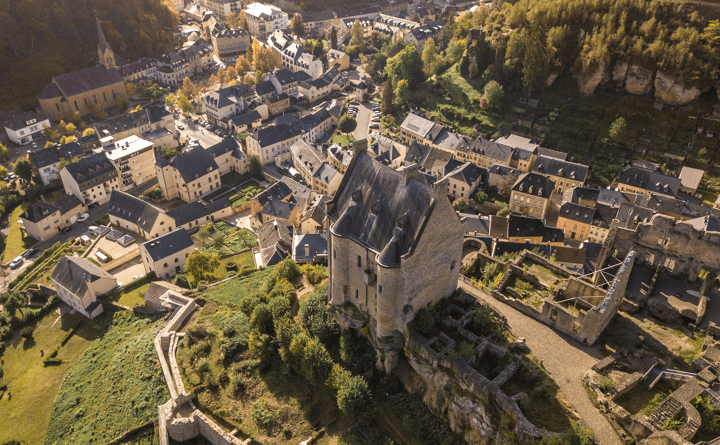
Best castles in Luxembourg
While Luxembourg is globally renowned for its prosperity, high standard of living, and flourishing financial industry, there's much more to this small yet remarkable country. The Grand Duchy boasts an incredible historical heritage characterized by the presence of sublime castles. In this article, we've curated a selection of the best castles in Luxembourg that you simply can't miss when visiting or residing in the country.
Luxembourg hosts one of the most beautiful castles in the world, as noted by CNN. Ranked 12th on their list of 21 castles worldwide, the Vianden Castle stands proudly, just after Edinburgh Castle.
Top 7 castles to visit in Luxembourg
Wondering how many castles are in Luxembourg? Prepare to be amazed. Despite its small size, Luxembourg boasts over 50 castles scattered throughout its territory. This abundance is a testament to the country's rich historical past and the power wielded by Luxembourgish dukes over the centuries.
Exploring these magnificent sites offers not just a journey into the country's history, but also opportunities to discover exhibitions, medieval and musical festivals, and even hiking trails through natural spaces. In the following sections, we will visit some of the most famous castles in Luxembourg.
Luxembourg’s castles have long become its calling card. And while the local landmarks may not match their German counterparts in beauty or sophistication, they still remain major attractions for both tourists and locals alike.
Besides castles, the Grand Duchy has a lot of beautiful places to visit. If you are planning to travel around Luxembourg and want some ideas of where to go, we recommend our article about beautiful places to visit in Luxembourg.
Vianden Castle

The Vianden Castle is open daily from 10:00 and closing times depend on the season according to the following calendar:
- 02.01 - 28.02 from 10.00 to 16.00
- 01.03 - 31.03 from 10.00 to 17.00
- 01.04 - 30.09 from 10.00 to 18.00
- 01.10 - 31.10 from 10.00 to 17.00
- 01.11 - 31.12 from 10.00 to 16.00
Situated in the northeastern town bearing its name, Vianden Castle perches atop a small hill, overlooking the village below. Its magnificent exterior resembles a fairy tale castle come to life.
Dating back to the 11th to 14th centuries, the castle was constructed upon the foundations of a Roman fort and a Carolingian refuge. For centuries, it served as the residence of dukes and counts of the Vianden canton until the House of Nassau inherited it in the late 15th century. Under the reign of William I of Orange-Nassau in the early 19th century, the castle was sold and gradually fell into ruin by 1820.
In 1890, ownership transferred to Grand Duke Adolphe of the Nassau dynasty, remaining in the grand ducal family's possession until 1977 when it became state property. Since then, it has been meticulously renovated and reconstructed, preserving its historical charm, and earning recognition as a European landmark.
Beyond its historical allure, Vianden Castle draws visitors with its vibrant medieval festivals. These events feature concerts of medieval music, sword fights, crossbow shooting shows, bird tamers, fire eaters, jugglers, poets, flag bearers, dancers, children's workshops, and a medieval market offering delights of yore.
Beaufort Castles

Renaissance castle
Guided tours from Thursday to Sunday at 11:00 and 16:00 (or on request)
Yes, you read that correctly, we're talking in plural because in Beaufort there are not just one but two castles. Situated in the town of the same name, slightly south of Vianden, in northeastern Luxembourg, these castles are nestled amidst majestic flora and fauna, alongside a tranquil pond that adds to the sense of serenity and harmony.
The medieval castle
The Renaissance castle
In 1981, the then lady of the castle, Mrs. Linckels Volmer, transferred both the medieval and Renaissance castles to the Luxembourgish state in exchange for a lifelong annuity with residence rights.
The castle offers guided tours and in summer, artists offer concerts in front of the castle, complemented by light shows. In addition, the castle is in a region called the Luxembourgish Little Switzerland, which is famous for its hiking trails, so it is not a bad idea to combine a visit to the castle with a hike and a few stops to discover the culinary specialties of the region.
New Castle of Ansembourg

The New Castle of Ansembourg lies north of the capital, approximately 25 minutes away, nestled in a protected area known as the Valley of the Seven Castles, within the Eisch Valley, safeguarded both nationally and across Europe since the 19th century.
Initiated in 1639-47 as the "master blacksmith's house" by Thomas Bidart, the "new castle" of Ansembourg gradually expanded under descendants, notably Thomas de Marchant in 1719 and his son, Lambert-Joseph de Marchant et d'Ansembourg, who was granted the title of count by Empress Maria Theresa of Austria in 1749.
As a privately-owned castle, visiting isn't possible on any given day, but the castle hosts a wide array of events, including guided tours, lectures, Heritage Days, castle parties, exhibitions, tastings, and interactive workshops. These events offer both enjoyment and a chance to appreciate the castle's majestic ambiance.
The castle is also renowned for its preserved Baroque terraced gardens, adorned with statues, staircases, and French-inspired Baroque fountains which can be visited on any given day. Additionally, the castle is available for private event rentals, offering a truly regal setting for special occasions.
Bourscheid Castle

- March 29, 2024 - October 15, 2024: from 9:30 to 18:00 (last admission at 17:30)
- October 16, 2024 - March 31, 2025: from 11:00 to 16:00 (last admission at 15:30)
Located in the northern region of Luxembourg's Ardennes, Bourscheid Castle rises majestically atop a hill, 150 meters above the Sûre River. With its 11 towers, it claims the title of the country's largest castle.
Commissioned by Lord Bertram von Bourscheid in 1000, the castle underwent four major expansion phases before its completion in 1430. Serving as the medieval residence of the respected Bourscheid family, it suffered abandonment in the 19th century like its neighbors, falling into ruin as a result.
It was declared a historical monument in 1936 and acquired by the State in 1972. Since then, extensive excavations and restoration work have been carried out and only two buildings within the castle walls have been rebuilt according to the old model: the porter's house and the Stolzembourg house.
In addition to exploring the ruins, the castle offers a unique treat: a breathtaking 360° view of the Luxembourg countryside. Before leaving, we recommend taking a glimpse of the castle at night, as the illuminated lights offer a spectacular sight.
Wiltz Castle

- September – June: Monday to Saturday from 09:00 to 12:00 and 14:00 to 17:00
- July – August: Every day from 9:00 to 18:00
Located in the northern region of Éislek, east of the town bearing its name, Wiltz Castle has a rich history dating back to the 13th century. Initially situated slightly north in Niederwiltz, its strategic location for city defense proved vulnerable to attacks, prompting relocation to a higher rocky spur. Construction of the new Renaissance castle began in 1631 under Count Jan's reign and was completed around 1720, standing tall to this day.
This castle stands out for its cultural offerings, it houses the National Brewery Museum, Tannery Museum, and the Battle of the Bulge Museum 1944/45. In addition, since the 1950s, the castle's monumental staircase leading to the garden and its facade have served as the backdrop for the Wiltz European Festival of Open-Air Theatre and Music.
Bourlingster Castle

Located just 15 kilometers northeast of the Luxembourgish capital and near Luxembourg Airport, Bourlingster Castle has a rich history dating back to the 11th century. Initially consisting of a keep, enclosure, and chapel, additional parts including the northern barracks and two defensive towers were added in the 16th century.
Unlike many castles, Bourlingster was never abandoned throughout history, passing from noble owner to commoner until its acquisition by the state in 1968. Today, the castle serves as a venue for important occasions such as weddings, business seminars, and other events.
Moreover, the castle is home to the Michelin-starred restaurant, La Distillerie, led by Chef René Mathieu. Renowned since 2012 and elected Chef of the Year 2010 for Luxembourg by the Gault Millau guide, Chef Mathieu and his team offer original cuisine and sophisticated pairings.
Larochette Castle

The castle of Larochette located northeast of the capital is a little less famous than the others, most likely because of its current state, as it is a ruin high in the mountains. The first buildings on the site date back to the 11th century and are located on a promontory of Luxembourg sandstone that overlooks the valley of the Ernz Blanche, a tributary of the Sûre, by about 50 meters.
The castle complex includes a well-preserved Gothic building, the Maison de Créhange, and a second house, the Maison D'Hombourg, which lies in ruins. Following a fire in 1565, the castle fell into ruin, but the Maison de Créhange was restored in 1980, while the Maison D'Hombourg remained untouched over time.
From the castle, you can enjoy a superb view of the Ernz Blanche valley and the picturesque village of Larochette.
Frequently Asked Questions (FAQ)
How many castles are there in Luxembourg?
Are there any castles near Luxembourg City?
What activities can you do at Luxembourg's castles?
Are there any guided tours available for Luxembourg's castles?
Source: luxembourg.public.lu, lequotidien.lu, edition.cnn.com, www.lelephant-voyageur.com, castle-vianden.lu, beaufortcastles.com, www.gcansembourg.eu, www.castle-bourscheid.lu, www.visitwiltz.lu, www.festivaldewiltz.lu, chateaubourglinster.lu
We took photos from these sources: castle-vianden.lu, beaufortcastles.com, visitluxembourg.com, castle-bourscheid.lu, visitwiltz.lu, chateaubourglinster.lu, mullerthal.lu